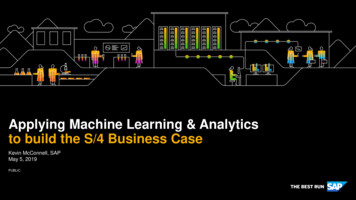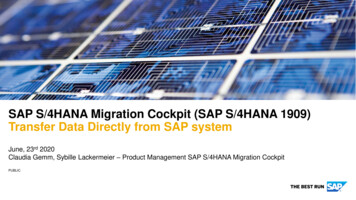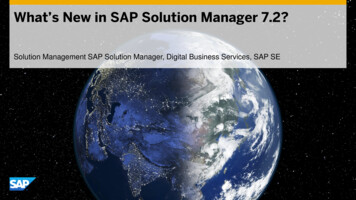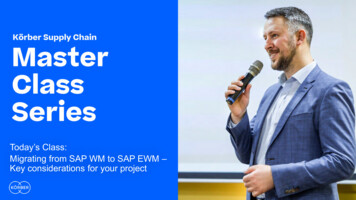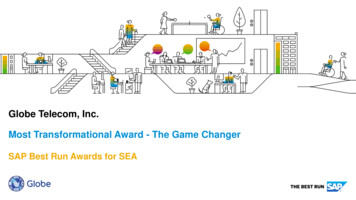
Transcription
IBM SAP International Competence CenterSAP University Competence Centerat Technical University of Munich:Next-generation IBM infrastructuresharpens students’ SAP skills forDigital Transformation
“ We have been partners with IBMfor many years and have hadgreat success with previousgenerations of IBM PowerSystems solutions. We knew fromprior experience that IBM PowerSystems provide an incrediblystable platform that we can relyon.”Dr. Harald KieneggerPost-Doctoral Researcher at the Chair for Information SystemsTechnical University of Munich (TUM)“ Through our SAP S/4HANA Cloudusing an SAP HANA TDIinfrastructure based on IBM PowerSystems, we are able to equip studentswith the latest tools and skills to drivethe Internet of Things and DigitalTransformation in the business world.”Helmut KrcmarProfessor of Information Systems andAcademic Director of the UCCTechnical University of Munich (TUM)
SAP University Competence Center at TechnicalUniversity of Munich: Next-generation IBM infrastructuresharpens students’ SAP skills for Digital TransformationAbout this paperThis paper describes how the SAP University Competence Center (UCC) at Technical University of Munich (TUM) uses IBMinfrastructure and automation technology to provide scalable, reliable and cost-efficient cloud services to its 247 customers in the SAPUniversity Alliance program. SAP UCC at TUM provides cutting-edge business applications including the SAP S/4HANA suite to 1,750lecturers and 52,000 students worldwide. To achieve this, SAP UCC uses the latest IBM POWER8 servers, high-performance IBM XIVstorage systems, IBM PowerVM virtualization in combination with the IBM PowerVC Virtualization Center cloud management solution,a combination of IBM DB2 and SAP HANA databases, and the IBM AIX and SUSE Linux Enterprise Server operating systems.Customer ObjectivesIBM and SAP Solution Use the available resources as efficiently as possible toprovide sophisticated services with low operating costsat an attractive price. Support traditional SAP Business Suite, SAP ERP, SAPBusiness Warehouse applications, SAP HANAdatabases and the SAP S/4HANA business application. Gain trust of peers with an SAP-certified, future-proof workloads – from one-off, short-lived environments topermanent solutions supporting large courses withEnable the SAP UCC at TUM to provide reliable cloudservices without a large team of system administrators.Ensure high availability and redundancy acrossall components. IBM PowerVM , IBM AIX IBM PowerVC Virtualization CenterIBM DB2 for Linux, UNIX and WindowsIBM Spectrum Protect (formerly Tivoli StorageIBM Tivoli MonitoringIBM Connections CloudSAP Solutions: hundreds or even thousands of students simultaneously. IBM XIV Manager)and scalable solution that supports a wide range of IBM Power System E870, IBM Power System S822Increase productivity within the team.SAP BusinessObjects Business IntelligenceSAP Business SuiteSAP Business WarehouseSAP ERPSAP Extended Warehouse ManagementSAP FioriSAP for HealthcareSAP for BankingSAP S/4HANASAP HANASAP Manufacturing ExecutionSAP Manufacturing Integration and Intelligence(SAP MII) 3SAP Mobile PlatformSAP Solution ManagerSUSE Linux Enterprise Server for SAP ApplicationsRed Hat Enterprise Linux
Customer Benefits Reduced provisioning time by 80 percent to just 30minutes for systems running on SUSE Linux Enterprisefor best performance and resource utilization acrossServer for SAP Applications.many logical partitions. Able to support SAP ERP environments with around 60datacenter integration is much easier to manage andcompared to previous CPU generations.blends seamlessly into the overall system landscape. Cut storage latency substantially with a reduction of upServices and SAP Certified in SAP HANAIBM POWER8 provides 4x faster memory bandwidthOperations Services. optimizes demand for physical memory and keepsUCC at TUM can almost double the memory capacity forresource utilization at a very high level. 50 percent and the highly efficient data compression ofnew infrastructure.IBM DB2 with BLU Acceleration even achieves savings ofMeasured the read throughput of the IBM XIV Storagenearly 70 percent. applications and have more fun interacting with theTested the write throughput of the IBM XIV Storagesoftware. new insights that were previously not easily availableMaintained price stability with no need to increase cloudor possible. Ensures automated data protection for SAP ERP andPaves the way for real-time analytics and supports new,high-speed business models. SAP HANA environments with a single toolset.Meets ‘on demand’ requests from lecturers andEncourages top executives to interact with businessdata directly in the central applications. students to provide reliable, scalable cloud services. Enables more-dynamic data analytics that can lead toto 600 percent.service fees over ten years. Students learn more quickly how they can use thepercent than the previous generation.System and identified performance improvements of up IBM DB2 data compression reduces database sizes byAchieved 99.99 percent system availability with itsSystem and found that the new solution was up to 500 Smart mix of IBM DB2 and SAP HANA databasesWith Active Memory Expansion factors of up to 1.8, SAPsome of its SAP ERP instances. Supports the ERPsim solution for hundreds ofstudents simultaneously.core without compromising memory performance. SAP Certified in Cloud Services, SAP Certified in Hostingto 75 percent.TUM to run more SAP HANA instances per processor Homogenous SAP HANA environment using tailoredpercent less IBM POWER8 processor allocationcompared to other architectures allowing SAP UCC at Supports granular and dynamic workload managementProvides highest levels of reliability, scalability andMigration from IBM POWER7 to IBM POWER8 withoutany downtime. performance for a growing portfolio ofbusiness applications.Allows SAP UCC at TUM to run a flexible, cost-efficienton-premises cloud platform for OpenStack.4
ContentsAbout this paper 3Customer Objectives 3IBM and SAP Solution 3Customer Benefits 4Background, starting point and objectives 6About SAP University Competence Center at Technical University of Munich 6Business challenges and project objectives 6Succeeding in the education sector 6Delivering a world-class cloud service 6Initial IT environment 7Technical solution 8Application landscape 8SAP standard software for learning 8Hands-on experience with next-generation tools 8Revolutionizing education with serious games 9Efficient service management and collaboration 9Migration project 10Server and storage migration 10Application migration – embarking on a digital reinvention journey with SAP S/4HANA 11System architecture 12Flexibility enables cloud services 13Taking advantage of IBM DB2 with BLU Acceleration 14Running SAP HANA on IBM POWER8 efficiently Data center operations 1415Managing flexible cloud services 15Next-level cloud deployments 15Standardized monitoring and backup processes 17Project achievements 18Efficient operations 18Quality certified by SAP 19Driving digital reinvention with SAP S/4HANA 20Performance improvements 20Benefits of IBM POWER8 20Effects of the latest XIV Storage System 21Rapid cloud deployment 21Next steps 22Business innovation with big data and the Internet of Things 22Launching the OpenPower Development Cloud 225
Background, starting point and objectivesBusiness challenges and project objectivesAbout SAP University Competence CenterSucceeding in the education sectorat Technical University of MunichAs a service provider in the education sector, the SAP UCC at TUMTechnical University of Munich (TUM) is one of the world’s leadingis exposed to cost pressures from all sides. Its customers oftentechnical universities, combining top-class facilities for cutting-have to cope with shrinking education budgets and, internally, theedge research with unique learning opportunities for more thanteam needs to keep down the cost of operations to avoid39,000 students. TUM offers 165 degree courses, encompassingoverstretching its finances.medicine, engineering, natural and life sciences, business studies,and education.To achieve its goal of providing reliable cloud services to a widerange of institutions, the SAP UCC at TUM had to implement a trulyTUM is a member of the SAP University Alliance program. Its Chairfuture-proof and scalable solution that would support a widefor Information Systems within the Department of Informaticsrange of workloads – from short-lived one-off introductions foroperates an SAP University Competence Center (UCC) and actslecturers to large courses with simulated business transactionsas an educational service provider. The SAP UCC at TUM offersrunning for hundreds or even thousands ofcloud services and educational resources and services to 1,750students simultaneously.lecturers and more than 52,000 students at 247 educationalinstitutions in the SAP University Alliance community worldwide.Dr. Harald Kienegger, Post-Doctoral Researcher at the Chair forInformation Systems at TUM, adds: “As education and researchThe SAP UCC at TUM predominantly serves higher educationpartner for SAP applications, we really needed gain the trust of ourinstitutions in the EMEA region, and is increasingly working withpeers in order to be successful with our cloud offering. Ourvocational schools to equip pupils with the software skills they willcustomers have to be confident that we can deliver a reliableneed in the world of work.service at any time for any number of students. To gain andmaintain this trust, certification from SAP was essential for us toAs the world’s first SAP UCC to support the SAP S/4HANA suite,prove to everyone that we can provide mission-critical services.”the SAP UCC at TUM plays a leading role in the SAP UniversityAlliance community. The SAP UCC at TUM helps other institutionsDelivering a world-class cloud serviceto discover the innovative features of the next-generation ERPThe SAP UCC at TUM quickly realized that it needed a solid,application hands-on, providing one-on-one training to lecturers,scalable foundation for its cloud solutions. As a service provider,and running learning systems for courses across the globe.maintaining the infrastructure and using the available resources asefficiently as possible is crucial to offering sophisticated servicesat an attractive price.6
Initial IT environmentTo ensure it could maintain the world-class quality of its services, itThe SAP UCC at TUM started working with IBM when it deployedwas imperative for the SAP UCC at TUM to renew its status as SAPIBM POWER7 servers for its SAP cloud services around 2010.Certified in Hosting Services and SAP Certified in SAP HANAThe team started with two IBM Power 750 Express servers inOperations Services. Making sure the new solution met the highcombination with two IBM BladeCenter H systems equippeddemands of the certification process would help to further boostwith six IBM POWER7 blade servers in total and IBM XIV Storagecustomer confidence and strengthen the position of the SAP UCCSystem solutions.at TUM within the community.The organization took advantage of IBM PowerVM , an advancedThe general move away from traditional ERP system towards next-virtualization technology, and operated its SAP applicationgeneration ERP solutions with real-time analytics supported by in-landscapes in logical partitions running the IBM AIX operatingmemory databases has increased the technical requirements forsystem supported by IBM DB2 for Linux, UNIX andthe center’s infrastructure. Maximilian Barnert, PhD candidate atWindows databases.TUM, explains: “We knew that we needed a future-proof solutionthat we can extend as the number of users grows and theAt the time, when the team migrated from SAP MaxDB to IBMdemands of innovative new applications rise. Lacking a bigDB2, SAP UCC at TUM saw database volumes shrink by up to 40budget, our focus was on finding a cost-efficient and flexiblepercent - despite moving to Unicode, which usually increases datainfrastructure that would enable us to provide automated cloudvolumes substantially.services without a large team of system administrators.”The SAP UCC at TUM relied on IBM Tivoli Monitoring to overseeFor best resource utilization and to benefit from economies ofits infrastructure and ensure round-the-clock availability.scale, the team identified virtualization and automation as the keysto success. High availability and redundancy across allAdrian Streitz, PhD candidate at TUM, recalls: “After moving from acomponents were important to ensuring customers that the SAPdifferent server platform, we were very satisfied with theUCC at TUM would be able to deliver the services they needed forperformance, ease of administration and support of the IBMtheir courses and students.POWER solution together with the reliable IBM XIV StorageSystem, which did not require any performance tuning or complexDominik Paluch, PhD candidate at TUM, summarizes: “Havingstorage management.”worked with IBM for six years, we have built great trust in both thetechnology and our partnership. Our experience taught us that wecan rely on the IBM systems and support. To communicate thistrust to our customers, we decided to get our SAP HANA TailoredData Center Integration certified by SAP.”7
Technical solutionUpgrading its IT infrastructure, SAP UCC at TUM deployed newgrowing demand for the SAP Manufacturing Integration andIBM Power System E870 and IBM Power System S822 serversIntelligence (SAP MII) application.with IBM POWER8 processors.Dr. Harald Kienegger comments: “We provide a wide range of SAPThe SAP UCC at TUM continues to use IBM PowerVM Enterprisesolutions to cover many different learning situations. We areEdition virtualization in combination with the IBM AIX and theespecially excited about demonstrating digital reinvention effortsSUSE Linux Enterprise Server operating systems to run a widedriven by the Internet of Things with applications such as SAPselection of SAP software together with IBM DB2 databases.Manufacturing Integration and Intelligence. These tools helpbusinesses to connect their equipment, people, and operations toFor data storage, SAP UCC at TUM today relies on the latesttheir extended supply chain. As a result, they can run theirgeneration of the IBM XIV Storage System. The high-end, grid-businesses in real-time with tightly integratedscale disk storage system provides the performance needed tomanufacturing processes.”offer scalable cloud services.Hands-on experience with next-generation toolsApplication landscapeThe SAP UCC at TUM also offers the next-generation SAPSAP standard software for learningS/4HANA Cloud suite powered by SAP HANA – the first SAP UCCThe SAP UCC at TUM operates approximately 140 SAP systemsin the world to do so. The innovative new software is designed withwith 108 IBM DB2 databases and a total data volume of 25 TB forthe role-based, responsive user experience of SAP Fiori andits customers. Depending on the individual requirements andmakes business applications seamlessly accessible acrossbudgets, the team either runs dedicated instances for specificdesktop and mobile devices. A pioneer in this space, the SAPinstitutions and courses or provides access to shared, more cost-UCC at TUM provides the SAP University Alliance program’sefficient multi-tenant systems as an alternative.global community with cloud services for conferences and withhands-on training for lecturers and students.The majority of its customers use the traditional SAP ERPapplication and SAP Business Warehouse for their courses.With current and future requirements firmly in sight, the SAP UCCHowever, some customers also request industry-specific softwareat TUM also hosts SAP Mobile Platform, enabling lecturers andsuch as the SAP for Healthcare or the SAP for Banking solutions.students to learn more about mobile business applications,empowering them to build and deploy mobile apps that keep staffIn addition, the SAP UCC at TUM can provide customconnected and support the digital reinvention within businesses.configurations for a special learning experience if requested. Forexample, the team had already implemented the SAP ExtendedBuilding further on the in-memory database SAP HANA, the SAPWarehouse Management and SAP Manufacturing ExecutionUCC at TUM also provides its customers with the advancedapplications specifically to support certain customers’analytics capabilities of SAP Business Warehouse in combinationlearning goals.with solutions from the SAP BusinessObjects Analytics portfolio,such as the SAP BusinessObjects Business Intelligence suite.Today, the on-going digitization of manufacturing processessupported by the Industrial Internet of Things (IIoT) is creating8
“ We are seeing growing interest inERPsim from our customers. As a cloudservice provider, this means that moretransactions are processed on oursystems and that we need to supportmore parallel workloads, leading tohigher performance requirements. As aresult, we need all the flexibility wecan get to use our resources asefficiently as possible.”Dr. Harald Kienegger summarizes: “We offer a verycomprehensive ‘education-as-a-service’ around SAP applications– from hosting to training. Our cloud services cover nextgeneration SAP software like SAP HANA platform and SAPS/4HANA to give lecturers and students real experience of thebusiness applications of the future – knowledge and skills that willbe valuable when students will get their first jobs.”Revolutionizing education with serious gamesDr. Harald KieneggerAs the exclusive partner in the EMEA region for ERPsim, a ground-Post-Doctoral Researcher at the Chair for Information Systemsbreaking simulation game, the SAP UCC at TUM takes anotherTechnical University of Munich (TUM)leading role in the community. To equip learners with essentialskillsets, the dynamic learning platform, ERPsim, provides a riskfree environment to explore and analyze realistic business data.Dr. Harald Kienegger elaborates: “We are seeing growing interestin ERPsim from our customers. As a cloud service provider, thismeans that more transactions are processed on our systems andthat we need to support more parallel workloads, leading to higherperformance requirements. As a result, we need all the flexibility4x faster memory bandwidthcompared to other architectureswe can get to use our resources as efficiently as possible to ensurea smooth ERPsim experience for the best, most realisticERP training.“With our new infrastructure in place, we want to make thesimulation game ready for the next-generation SAP S/4HANA suiteand take the prospect of digital reinvention and the emergingInternet of Things technology into account. Our goal is to createmore complex scenarios that include big data analytics todemonstrate the power of in-memory solutions running on our IBMPOWER infrastructure.”Efficient service management and collaborationThe team at the SAP UCC at TUM has also transformed internalprocesses by embracing IBM Tivoli Monitoring and SAP SolutionManager, streamlining and simplifying application monitoring andsupport. Users can now report incidents directly from within the9
Migration projectSAP ERP application, making it much easier to flag up issues orServer and storage migrationrequest support when needed. Furthermore, relevant system dataThe SAP UCC at TUM was eager to take advantage of the latestis captured automatically. Support requests can then beIBM POWER technology and decided to migrate its servers fromcategorized and automatically and flexibly assigned to the relevantIBM POWER7 to IBM POWER8 . Dominik Paluch explains: “Ourpeople at the help desk.data center is also a research lab so naturally we always want toget our hands on the most advanced technologies to evaluateAdrian Streitz says: “With IBM Tivoli Monitoring and SAP Solutionwhat benefits they actually bring and how those improvementsManager, we have significantly improved our incidentaffect data center operations.”management capabilities. With just a few minor customizations,we were able to adapt the standard solution to our specificDr. Harald Kienegger says: “We have been partners with IBM forrequirements. Users now benefit from a quick and easy way to getmany years and have had great success with previous generationsin touch with us. We at the help desk have a complete solution withof IBM Power Systems solutions. We knew from prior experiencethe Integrated Customer Solution Database, where we can rapidlythat IBM Power Systems provide an incredibly stable platform thatsearch for solutions to common problems and build up a strongwe can rely on. We also know that we can depend on IBM for top-internal knowledge base to ensure the swift resolution ofquality support – we have a great relationship with the team andrecurring problems.”they are always ready and willing to help. Our decision to selectIBM POWER8 was based on total confidence that the IBM PowerThanks to SAP Solution Manager, the team can also easily forwardSystems platform delivers all of the capabilities we need.”messages to the SAP Support back-office if the help desk at theSAP UCC at TUM cannot solve the problem internally. RemoteThe team worked together with IBM to deploy new IBM Powersupport integration enables application sharing between users,System E870 and IBM Power System S822 servers. Staying withhelp desk staff, and SAP Support back-office experts. Reportingthe IBM POWER architecture, the SAP UCC at TUM could usefeatures help the SAP UCC at TUM to assess service quality andtheir existing knowledge and experience of IBM POWER7 toensure customer satisfaction.prepare and complete the migration to the new IBM POWER8servers without interrupting its services. Adrian Streitz adds: “WeTo increase productivity within the team, the SAP UCC at TUMused the IBM PowerVM feature Live Partition Mobility to move ourconsolidated all of its documentation onto a single platform. Dr.140 SAP instances to the new IBM Power Systems servers withoutHarald Kienegger comments: “To facilitate knowledge-sharingany downtime during business hours. The migration was verywithin our team and have all relevant information at one place, wesmooth and the procedure can be started from the graphical usermoved four different wiki systems onto the IBM Connectionsinterface, making the process straightforward and easyCloud – that way, we no longer need to manage and maintain fourto manage.”separate systems. Instead, we can focus our services and have asingle resource for all relevant documentation. This helps to ensureTo minimize the risk of any effects on its users, the SAP UCC atsmooth internal processes and improve the quality of ourTUM chose to migrate the system outside of peak hours, but stillcloud services.”during term time while users were accessing the learning systems.The actual migration time of the systems depended on the size ofeach individual partition and took between one minute and half an10
hour. Dominik Paluch says: “For an administrator, it’s as easy asexample. Furthermore, we can take big data into account, such aspushing a button. In the background, however, the process isdata streams for social media analytics and sentiment analysis tomore complex. Live Partition Mobility basically configures a fully-gain new insights about the customers.automated, temporary high-availability cluster and the migrationhappens when the cluster switches over from one partition to the“SAP S/4HANA allows us to think about and use data within theother. For our SAP applications we did not need to make anyERP application more innovatively to enable our example companychanges, we only had to adjust the CPU assignments after theto modernize its business model. To demonstrate thesemigration to make full use of the increased performance of the IBMcapabilities, we want to show what predictive analytics means in aPOWER8 processors.”business context.”Upgrading its storage environment to IBM XIV Gen 3 storagesystems was completed over two subsequent maintenance“ We are planning to make use of thenew capabilities to showcase acomplete digital reinvention processwith our example company. With SAPS/4HANA on IBM POWER8, we canintegrate Internet of Things data fromproduction equipment to develop moreadvanced business processes.”windows without affecting users. Over the process of migratingthe storage volumes for each logical partition, each individual SAPsystem was only down for approximately ten minutes.Application migration – embarking on a digital reinvention journeywith SAP S/4HANAAs well as upgrading its infrastructure, the SAP UCC at TUMworked to adapt its learning environment to the next-generationSAP S/4HANA suite. The team quickly migrated its existingMaximilian Barnertexample company to the new solution, providing lecturers andPhD candidate at the Chair for Information Systemsstudents with the latest SAP software for their courses.Technical University of Munich (TUM)By integrating transactional and analytical features on a singleplatform, SAP managed to streamline and simplify the data modelin SAP S/4HANA. As a result, the systems are smaller and lesscomplex than in the past, as data no longer needs to besynchronized and stored redundantly for analytics purposes.This convergence of operational and analytical data also lays thefoundations for the digital reinvention of businesses. MaximilianBarnert explains: “We are planning to make use of the newcapabilities to showcase a complete digital reinvention processReduced provisioning time by80 percent to just 30 minuteswith our example company. With SAP S/4HANA on IBM POWER8,we can integrate Internet of Things data from productionequipment to develop more advanced business processes, for11
System architectureTogether with IBM, the SAP UCC at TUM evaluated severalto reassign those capacities to a number of smaller systems. Withdifferent options for its comprehensive SAP applicationIBM PowerVM, we can dynamically adjust the computing andlandscape. While it was clear that they would be keeping the IBMmemory allocations to always provide the best performance at thePOWER platform, they discussed the various pros and cons oflowest cost.”scale-out and scale-up system architectures. To create a costefficient infrastructure for the SAP HANA platform and SAPIn addition, the SAP UCC at TUM also implemented two IBMS/4HANA suite, the team opted for an SAP HANA tailored dataPower System S822 servers, each equipped with 12 POWER8center integration (TDI).processor cores.Maximilian Barnert clarifies: “We looked at our workload andAs the entire team is made up of researchers, the SAP UCC atquickly decided to follow a scale-up approach with two large IBMTUM has no single full-time storage administrator. One challengePower System E870 servers with 40 cores each. The SAP HANAwas to find a solid, scalable storage system that would worktailored data center integration simply gave us more freedom towithout continuous manual tuning. Based on its positiveflexibly distribute the available resources across all customerexperience with the technology, the team chose the new third-instances – SAP HANA and SAP ERP. Sometimes we need to shiftgeneration IBM XIV Storage System.capacity to a large application for a course, and later we will haveEthernet SwitchMunich ScientificNetwork (MWN)10 Gbit/s external networkconnectivityIBM PowerSystem S822IBM PowerSystem S8222x IBM VIOSIBM Power SystemE8702x IBM VIOSIBM Power SystemE870IBM PowerHA, TSA8 Gbit/s SANIBM System StorageSAN48B-5 switch10 Gbit/s external networkconnectivity8 Gbit/s SANInter Switch Link (ISL ) TrunksSANIBM System StorageSAN48B-5 switch1 Gbit/smanagementLANIBM XIV Gen3Storage SystemIBM XIV Gen 3Storage SystemFigure 1: Overview of the new IBM solution at SAP UCC at TUM.12SANBackup withIBM Spectrum Protect(formerly TSM)IBM System StorageTape Library(remote)
Flexibility enables cloud servicesAdrian Streitz remarks: “With our goal to keep storageAt the SAP UCC at TUM none of the four IBM Power Systems administration workload at a minimum without compromisingserver is dedicated to a single system. All machines run a numberperformance or availability, IBM XIV storage systems were theof logical partitions (LPARs) to minimize the operating cost for allideal solution. IBM XIV technology is based on a grid architecturecloud services, managed with the IBM PowerVM virtualizationthat ensures reliability and provides redundancy out of the box.technology. Dominik Paluch notes: “The flexibility and scalability ofThis combination allows us to operate our SAP environmentPowerVM are very important for our business model. For example,without any manual storage management. To ensure the highestfor some courses we know that 8,000 students will be logging in atof availability, data is mirrored from our primary IBM XIV system toonce and we have to make sure to provide the required capacityour secondary device using the standard functionality of the IBMwhen it’s needed, without blocking it at times when it would beXIV storage system. The IBM XIV systems also constantly optimizebetter used for other logical partitions.the location of data on its physical disks, providing maximumperformance and redundancy fully autonomously, without the“We also rely heavily on the Active Memory Expansion feature. Theneed for manual intervention.”fact that the IBM POWER8 processor is so fast helps with the onthe-fly compression of data in memory. While we run manyAll IBM infrastructure components are spread evenly across twosystems with a compression factor of about 1.3, for some systemsserver rooms for the best redundancy and business continuity.we use up to 1.8 – almost doubling the memory capacity availableto applications.”IBM POWER8 ServerIBM POWER8 with 40 cores each having 4,2 GHz,4 TB RAM, internal HDDs for IBM Virtual I/O Server (VIOS)2 cores, 128
infrastructure and automation technology to provide scalable, reliable and cost-efficient cloud services to its 247 customers in the SAP University Alliance program. SAP UCC at TUM provides cutting-edge business applications including the SAP S/4HANA suite to 1,750 lecturers and 52,000 students worldwide.



